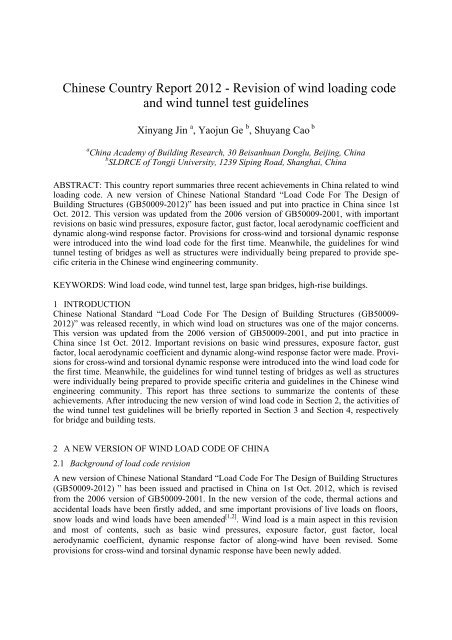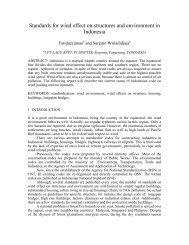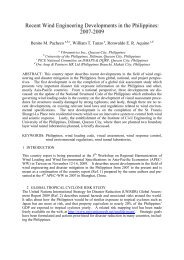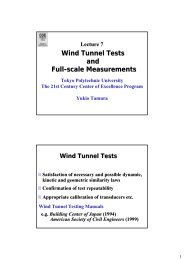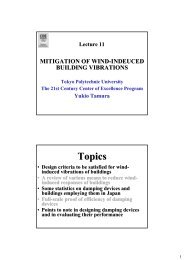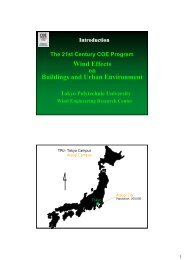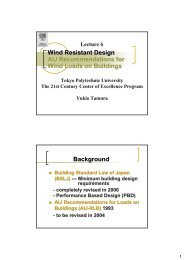Chinese Country Report 2012 - Revision of wind loading code and ...
Chinese Country Report 2012 - Revision of wind loading code and ...
Chinese Country Report 2012 - Revision of wind loading code and ...
You also want an ePaper? Increase the reach of your titles
YUMPU automatically turns print PDFs into web optimized ePapers that Google loves.
<strong>Chinese</strong> <strong>Country</strong> <strong>Report</strong> <strong>2012</strong> - <strong>Revision</strong> <strong>of</strong> <strong>wind</strong> <strong>loading</strong> <strong>code</strong><strong>and</strong> <strong>wind</strong> tunnel test guidelinesXinyang Jin a , Yaojun Ge b , Shuyang Cao ba China Academy <strong>of</strong> Building Research, 30 Beisanhuan Donglu, Beijing, Chinab SLDRCE <strong>of</strong> Tongji University, 1239 Siping Road, Shanghai, ChinaABSTRACT: This country report summaries three recent achievements in China related to <strong>wind</strong><strong>loading</strong> <strong>code</strong>. A new version <strong>of</strong> <strong>Chinese</strong> National St<strong>and</strong>ard “Load Code For The Design <strong>of</strong>Building Structures (GB50009-<strong>2012</strong>)” has been issued <strong>and</strong> put into practice in China since 1stOct. <strong>2012</strong>. This version was updated from the 2006 version <strong>of</strong> GB50009-2001, with importantrevisions on basic <strong>wind</strong> pressures, exposure factor, gust factor, local aerodynamic coefficient <strong>and</strong>dynamic along-<strong>wind</strong> response factor. Provisions for cross-<strong>wind</strong> <strong>and</strong> torsional dynamic responsewere introduced into the <strong>wind</strong> load <strong>code</strong> for the first time. Meanwhile, the guidelines for <strong>wind</strong>tunnel testing <strong>of</strong> bridges as well as structures were individually being prepared to provide specificcriteria in the <strong>Chinese</strong> <strong>wind</strong> engineering community.KEYWORDS: Wind load <strong>code</strong>, <strong>wind</strong> tunnel test, large span bridges, high-rise buildings.1 INTRODUCTION<strong>Chinese</strong> National St<strong>and</strong>ard “Load Code For The Design <strong>of</strong> Building Structures (GB50009-<strong>2012</strong>)” was released recently, in which <strong>wind</strong> load on structures was one <strong>of</strong> the major concerns.This version was updated from the 2006 version <strong>of</strong> GB50009-2001, <strong>and</strong> put into practice inChina since 1st Oct. <strong>2012</strong>. Important revisions on basic <strong>wind</strong> pressures, exposure factor, gustfactor, local aerodynamic coefficient <strong>and</strong> dynamic along-<strong>wind</strong> response factor were made. Provisionsfor cross-<strong>wind</strong> <strong>and</strong> torsional dynamic response were introduced into the <strong>wind</strong> load <strong>code</strong> forthe first time. Meanwhile, the guidelines for <strong>wind</strong> tunnel testing <strong>of</strong> bridges as well as structureswere individually being prepared to provide specific criteria <strong>and</strong> guidelines in the <strong>Chinese</strong> <strong>wind</strong>engineering community. This report has three sections to summarize the contents <strong>of</strong> theseachievements. After introducing the new version <strong>of</strong> <strong>wind</strong> load <strong>code</strong> in Section 2, the activities <strong>of</strong>the <strong>wind</strong> tunnel test guidelines will be briefly reported in Section 3 <strong>and</strong> Section 4, respectivelyfor bridge <strong>and</strong> building tests.2 A NEW VERSION OF WIND LOAD CODE OF CHINA2.1 Background <strong>of</strong> load <strong>code</strong> revisionA new version <strong>of</strong> <strong>Chinese</strong> National St<strong>and</strong>ard “Load Code For The Design <strong>of</strong> Building Structures(GB50009-<strong>2012</strong>) ” has been issued <strong>and</strong> practised in China on 1st Oct. <strong>2012</strong>, which is revisedfrom the 2006 version <strong>of</strong> GB50009-2001. In the new version <strong>of</strong> the <strong>code</strong>, thermal actions <strong>and</strong>accidental loads have been firstly added, <strong>and</strong> sme important provisions <strong>of</strong> live loads on floors,snow loads <strong>and</strong> <strong>wind</strong> loads have been amended [1,2] . Wind load is a main aspect in this revision<strong>and</strong> most <strong>of</strong> contents, such as basic <strong>wind</strong> pressures, exposure factor, gust factor, localaerodynamic coefficient, dynamic response factor <strong>of</strong> along-<strong>wind</strong> have been revised. Someprovisions for cross-<strong>wind</strong> <strong>and</strong> torsinal dynamic response have been newly added.
2.2 Expressions <strong>of</strong> <strong>wind</strong> load for main structures <strong>and</strong> claddingsThe expressions <strong>of</strong> <strong>wind</strong> load for design <strong>of</strong> main structures <strong>and</strong> claddings are kept in the same.The <strong>wind</strong> pressure (<strong>wind</strong> force per unit area) normally acted on surface <strong>of</strong> buildings <strong>and</strong> structuresfor design <strong>of</strong> main structures should be calculated as:W W 0(2.1)k z S zWhere W k =characteristic value <strong>of</strong> <strong>wind</strong> pressure ( kN/m 2 ); Z =dynamic response factor at theheight <strong>of</strong> z; S = aerodynamic pressure coefficient; Z = pressure exposure factor; W 0 = basic<strong>wind</strong> pressure( kN/m 2 ).The <strong>wind</strong> pressure normally acted on surface <strong>of</strong> structural parts for design <strong>of</strong> <strong>wind</strong>ows, doors<strong>and</strong> clddings should be calculated as:WkzgSl zW 0 (2.2)Where zg = gust factor at the height <strong>of</strong> z; sl = local aerodynamic coefficient.Basic <strong>wind</strong> pressure is determined as:1 W20 v 0(2.3)2where v 0 = reference <strong>wind</strong> speed (m/s), which is defined as the 10-minute mean <strong>wind</strong> speed overa flat <strong>and</strong> open terrain at an elevation <strong>of</strong> 10m with a mean return period <strong>of</strong> 50 years; ρ= airdensity (t/m 3 ).The climate data from the year <strong>of</strong> 1995 to 2008 have been added in the statistical samples, <strong>and</strong>the referece <strong>wind</strong> speed for more than 600 stations have been renewed together with the country<strong>wind</strong> map in the new version <strong>of</strong> the <strong>code</strong>.2.3 Exposure factor4 categories <strong>of</strong> ground roughness (A sea <strong>and</strong> lake, B open countryside, C towns <strong>and</strong> cities, Dcenter <strong>of</strong> large cities) are kept in the same <strong>and</strong> the power low velocity pr<strong>of</strong>ile is yet used. Thevalue <strong>of</strong>αfor B category <strong>and</strong> the gradient heights <strong>of</strong> C <strong>and</strong> D categories have been changed asshown in Table 2.1.Table 2.1 Ground roughnessCategories <strong>of</strong> ground roughness A B C DGB50009-2001 Gradient height(m) 300 350 400 450α 0.12 0.16 0.22 0.30GB50009-<strong>2012</strong> Gradient height(m) 300 350 450 550α 0.12 0.15 0.22 0.30The expressions <strong>of</strong> exposure factor for <strong>wind</strong> pressure are then given as follows:A z z1.284 10 0.24;B z z1.000 10 0.30;C z z0.544 10 0.44;D z z0.262 10 0.60(2-3)
The variation <strong>of</strong> <strong>wind</strong> velocity pr<strong>of</strong>ile is shown in Figure 2.1. It can be found clearly that the values<strong>of</strong> exposure factors are decreased.H(m)500400300200ABCDA newB newC newD new10001 1.5 2 2.5 3 zFigure 2.1 Difference <strong>of</strong> <strong>wind</strong> velocity pr<strong>of</strong>ile2.4 Gust factorThe new expression <strong>of</strong> gust factor is as follows: z zg 12gI10 (2.4)10Where g = peak factor; I 10 = coefficient for turbulent. The value <strong>of</strong> g has been changed from 2.2to 2.5, <strong>and</strong> the values <strong>of</strong> I 10 are increased as shown in Table 2.2.Figure 2.2 shows the variation <strong>of</strong> the peak <strong>wind</strong> pressure pr<strong>of</strong>ile. It can be found that the peak<strong>wind</strong> loads used for design <strong>of</strong> claddings are increased.Table 2.2 Values <strong>of</strong> coefficients I 10Categories <strong>of</strong> ground roughness A B C DGB50009-2001 0.088 0.114 0.167 0.278GB50009-<strong>2012</strong> 0.120 0.140 0.230 0.390Figure 2.2 Peak <strong>wind</strong> pressure pr<strong>of</strong>ile
2.5 Along-<strong>wind</strong> dynamic response factorThe expression <strong>of</strong> along-<strong>wind</strong> dynamic response factor has been changed to as follows:2z( z) 12gI10Bz1 R(2.5)Bz ( z)kH( z)(2.6)a1 1 x zzx21(1 x24/31 1 )R (2.7)630 fx , x 5(2.8)11 1kw w 0Where Bz= background response factor; R = resonant response factor; f 1= structural naturalfrequency; 1=structural damping ratio; k w= modification factor <strong>of</strong> ground roughness (1.28,1.0, 0.54 <strong>and</strong> 0.26 for A, B, C <strong>and</strong> D); ( z)= modal shape; 1 x , z = correlation coefficient;k, a 1 = coefficient given in Table 2.3.Table 2.3 Values <strong>of</strong> coefficients k <strong>and</strong> a 1Ground roughness A B C Dbuildingk 0.944 0.670 0.295 0.112a 1 0.155 0.187 0.261 0.346towerk 1.276 0.910 0.404 0.155a 1 0.186 0.218 0.292 0.376The values <strong>of</strong> zwill be increased because <strong>of</strong> the increase <strong>of</strong> g <strong>and</strong> I 10 though the theory <strong>and</strong>methodology used kept in the same (Figure 2.3). The base shear <strong>and</strong> moment <strong>of</strong> <strong>wind</strong> load is increasedfor high-rise buildings with total height below 350m (Figure 2.4).Figure 2.3 Difference <strong>of</strong> dynamic response factorsFigure 2.4 Difference <strong>of</strong> shear force
2.6 Cross-<strong>wind</strong> <strong>and</strong> torsional dynamic response2.6.1 cross-<strong>wind</strong> equivalent <strong>wind</strong> loadFor rectangular plan high-rise buildings with 4≤H/B≤8, 0.5≤D/B≤2 <strong>and</strong> vT / H L1BD≤10,the equivalent <strong>wind</strong> load induced by cross-<strong>wind</strong> dynamic repose <strong>of</strong> structure is expressed as follows[3-5] :2w gw C R(2.9)1Lk 0 z LLC L(2 2 ) CmCM(2.10)DCMCR 0.019 B 2.54(2.11)Cm1.5 2 2.5 b b b 1.00 81.6 301 290 0.05 b/B 0.2case 1 B B B 0.5 1.5 2 b b b 1.00 2.05 24 36.8 0.05 b/B 0.2case 2 B B B(2.12)S C /RL K L4( )2FLsm CM1 a1(2.13)KL1.4 z 0.95 C H1m20.91T T T*2 * *20.0025 0.000125L1 L1 L1a1 *22*2T0.0291TL1L1(2.14)(2.15)* vTH L1T L1(2.16)9.8BWhere CL=lateral force coefficient; RL=resonant factor <strong>of</strong> cross-<strong>wind</strong> vibration; SF L=power*spectral density function <strong>of</strong> lateral force, given in Figure 2.5 ( f f B/ vL1 L1 H); Cm, Csm= modificationfactor <strong>of</strong> force <strong>and</strong> spectrum for corner shape (Figure 2.6, Table2.4); C R=factor <strong>of</strong>ground roughness (0.236, 0.211, 0.202 <strong>and</strong> 0.197 for A to D); =aerodynamic damping ratio;*TL1 = reduced period.a1
2.01.80.070.072.01.80.070.050.03D/B1.60.10.005 0.0030.0071.40.050.011.2 0.030.0070.031.0 0.0020.10.20.80.0030.005 0.01 0.071E-30.10.20.0020.60.05 0.10 0.15 0.20 0.25f * L1 A 类 地 貌(a)D/B1.61.41.21.00.80.60.030.010.0031E-30.050.070.10.030.070.10.0050.010.0070.0030.0021E-30.05 0.10 0.15 0.20 0.25f * L1B 类 地 貌(b)2.00.002 1E-32.01.80.031.80.003D/B1.61.41.21.00.80.60.020.010.0050.0021E-35E-40.050.030.010.0050.07 0.020.07 0.10.050.07D/B1.61.41.21.00.80.60.040.020.030.020.030.050.010.0031E-35E-40.0070.010.0050.0021E-30.05 0.10 0.15 0.20 0.250.1 f * L1 C 类 地 貌(c)0.05 0.10 0.15 0.20 0.250.05f * D 类 地 貌L1(d)Figure 2.5 power spectral density function <strong>of</strong> lateral forcebBb(a) case 1 (b) case 2Figure 2.6 Corner shape2.6.2 Torsional equivalent <strong>wind</strong> loadFor rectangular plan high-rise buildings with H ≤6, 1.5≤D/B≤5 <strong>and</strong> TT1vH≤10, the equivalentBDBD<strong>wind</strong> load induced by torsional dynamic repose <strong>of</strong> structure is expressed as follows:0.9 z 2wTk 1.8gw0HCT 1RTH(2.17)bBb
0.30.550.20.40.150.050.001Table 2.4 Values <strong>of</strong> coefficient Csmcase*GroundReduced frequency ( f )b/BL1roughness0.100 0.125 0.150 0.175 0.200 0.225 0.2505% 0.183 0.905 1.2 1.2 1.2 1.2 1.1B 10% 0.070 0.349 0.568 0.653 0.684 0.670 0.653120% 0.106 0.902 0.953 0.819 0.743 0.667 0.6265% 0.368 0.749 0.922 0.955 0.943 0.917 0.897D 10% 0.256 0.504 0.659 0.706 0.713 0.697 0.68620% 0.339 0.974 0.977 0.894 0.841 0.805 0.7905% 0.106 0.595 0.980 1.0 1.0 1.0 1.0B 10% 0.033 0.228 0.450 0.565 0.610 0.604 0.594220% 0.042 0.842 0.563 0.451 0.421 0.400 0.4005% 0.267 0.586 0.839 0.955 0.987 0.991 0.984D 10% 0.091 0.261 0.452 0.567 0.613 0.633 0.62820% 0.169 0.954 0.659 0.527 0.475 0.447 0.4532 D B 0.78C T 0.0066 0.015( / )(2.18)R K FTTT(2.19)41KB D z 20rH2 2( )T 20.1(2.20)Where CT=torsional force coefficient;spectral density function <strong>of</strong> torsion;f( * T1fT1vHBD ).54.50.40.30.1RT=resonant factor <strong>of</strong> torsional vibration;SF L= powerFT= energy factor <strong>of</strong> torsional spectrum, given in Figure 2.70.020.010.00540.0013.50.30.00230.20.0050.012.50.50.0220.150.20.150.11.50.1 0.2 0.3 0.4 0.5 0.6 0.7 0.8 0.9 1Figure 2.7 energy factor <strong>of</strong> torsional spectrum0.002
2.7 Combination <strong>of</strong> along-<strong>wind</strong>, cross-<strong>wind</strong> <strong>and</strong> torsional <strong>wind</strong> loadAlong-<strong>wind</strong>, cross-<strong>wind</strong> <strong>and</strong> torsional <strong>wind</strong> load given as following should be combined accordingto Table 2.5.F ( w w ) B(2.21)Dk k1 k2FLk w B(2.22)LkTable 2.5 Wind load combinationT2Tk wTkB(2.23)Load case Along-<strong>wind</strong> Cross-<strong>wind</strong> Torsional1 F - -Dk2 0.6F DkFLk-3 - - TTk3. CRITERIA AND GUIDELINE FOR WIND TUNNEL TESTING OF BRIDGESWith the origination <strong>and</strong> development <strong>of</strong> boundary layer <strong>wind</strong> tunnels by Jack E. Cermak<strong>and</strong> Alan G. Davenport in the 1960’s, the effects <strong>of</strong> <strong>wind</strong> for bridges <strong>and</strong> structures have beencommonly determined through <strong>wind</strong> tunnel model studies, which include measurements <strong>of</strong> varioustypes <strong>of</strong> information <strong>of</strong> interest, such as cladding loads, structural loads <strong>and</strong> pedestrian level<strong>wind</strong> speeds. In order to assist researchers <strong>and</strong> engineers who may become involved with the<strong>wind</strong> tunnel model testing, each country, area or institute may have their own appropriate criteria<strong>and</strong> guideline to specify <strong>wind</strong> tunnel testing with various models, which results in several guidelinesor manuals <strong>of</strong> practice in the world, for example, the ASCE Manual <strong>of</strong> Practice for WindTunnel Studies <strong>of</strong> Buildings <strong>and</strong> Structures in 1987 <strong>and</strong> 1999 [6], the Wind Tunnel Testing: AGeneral Outline (University <strong>of</strong> Western Ontario) in 1991 <strong>and</strong> 2007 [7], the AIJ Guideline forWind Tunnel Testing <strong>of</strong> Buildings in Japan in 1994 <strong>and</strong> 2009 [8], the Wind Tunnel Experimentsfor Honshu-Shikoku Bridges in Japan in 1980 [9], the Wind Resistant Design Guidelines forHighway Bridges in China in 1996 [10], the Wind Resistant Design Specification for HighwayBridges in China 2004 [11], <strong>and</strong> so on. While the first three guidelines or manuals <strong>of</strong> practicepublished mainly involve in buildings <strong>and</strong> structures, the next three certainly relate to bridges.These documents may have some underlying differences between one to another.Under the globalization <strong>of</strong> the construction industry <strong>and</strong> the development <strong>of</strong> unified international<strong>code</strong>s <strong>and</strong> st<strong>and</strong>ards, it is believed that it is necessary to provide practical unified experimentalmethodology on the aerodynamics <strong>and</strong> aeroelastics <strong>of</strong> a wide range <strong>of</strong> bridges <strong>and</strong> bridgeelements, such as decks, pylons, cables, hangers <strong>and</strong> so on. Thus <strong>Chinese</strong> <strong>wind</strong> engineeringcommunity, under the leadership <strong>of</strong> State Key Laboratory for Disaster Reduction in Civil Engineering<strong>and</strong> Tongji University, are working to provide a contribution towards a specific <strong>and</strong>agreed criteria <strong>and</strong> guideline <strong>of</strong> <strong>wind</strong> tunnel testing <strong>of</strong> bridges, in particular with long spans. Inorder to achieve this goal, following studies are being conducted:(1) To study model law <strong>and</strong> similitude theory <strong>of</strong> <strong>wind</strong> tunnel testing <strong>of</strong> bridge aerodynamics<strong>and</strong> aeroelastics;(2) To investigate testing procedures <strong>and</strong> experimental techniques <strong>of</strong> model studies inboundary layer <strong>wind</strong> tunnels;
(3) To assess the validity <strong>and</strong> consistency <strong>of</strong> interpreting or extrapolating methods formodel testing results to the prediction <strong>of</strong> full-scale prototype behavior.4. GUIDELINE FOR WIND TUNNEL TESTING OF BUILDING STRUCTURESIn the <strong>Chinese</strong> <strong>wind</strong> engineering community, currently there is no <strong>of</strong>ficial guideline on the<strong>wind</strong> tunnel tests <strong>of</strong> building structures. Practically people <strong>of</strong>ten refer to ASCE Manual <strong>of</strong> Practicefor Wind Tunnel Studies <strong>of</strong> Buildings <strong>and</strong> Structures [6], the AIJ Guideline for Wind TunnelTesting <strong>of</strong> Buildings in Japan [8] <strong>and</strong> others. China Academy <strong>of</strong> Building Research is taking theaction in establishing a guideline for <strong>wind</strong> tunnel testing <strong>of</strong> building structures, which is estimatedto function as a national <strong>code</strong>. All the <strong>wind</strong> engineering groups in China are invited intothe technical committee, <strong>and</strong> the documental work is proceeded through intensive discussions.One feature <strong>of</strong> this guideline is that it covers the numerical approach (CFD) for assessingthe <strong>wind</strong> load on structures.3 REFERENCES1 Xinyang JIN, Jida Zhao, Development <strong>of</strong> design <strong>code</strong> for building structures in China, Structural Engineering International,SEI Volume 22, Number 2, (<strong>2012</strong>)195-201.2 Xinyang JIN, Principles <strong>and</strong> main points for the revision <strong>of</strong> Load <strong>code</strong> for the design <strong>of</strong> building structures,Journal <strong>of</strong> building structures, Vol. 32 No.12, 2011, 29-35.3 Yi Tang, Ming Gu, Xinyang Jin, Research on Wind-Induced Response <strong>of</strong> Structurally Asymmetric Tall Buildings[J],JOURNAL OF TONGJI UNIVERSITY(NATURAL SCIENCE), 38(2), 20104 M. Gu, Y. Quan, Across-<strong>wind</strong> loads <strong>of</strong> typical tall buildings[J], Journal <strong>of</strong> Wind Engineering <strong>and</strong> IndustrialAerodynamics, 92(2004) 1147-1165.5 QUAN Yong, GU Ming, Power Spectra <strong>of</strong> Across- <strong>wind</strong> Loads on Super High- rise Buildings[J], JOURNAL OFTONGJI UNIVERSITY(NATURAL SCIENCE), 30(5), 2002.6 American Society <strong>of</strong> Civil Engineers, ASCE Materials <strong>and</strong> <strong>Report</strong>s on Engineering Practice No. 67, Wind TunnelStudies <strong>of</strong> Buildings <strong>and</strong> Structures, the first edition in 1987, the edition <strong>of</strong> 1999.7 Boundary Layer Wind Tunnel Laboratory <strong>of</strong> University <strong>of</strong> Western Ontario, Wind Tunnel Testing: A GeneralOutline, the first issue in 1991 <strong>and</strong> the latest issue in 2007.8 Architectural Institute <strong>of</strong> Japan, Guideline for Wind Tunnel Testing <strong>of</strong> Buildings (in Japanese), the first edition in1994, the second edition in 2008.9 Honshu-Shikoku Bridge Bureau, Wind Tunnel Experiments for Honshu-Shikoku Bridge (in Japanese), 1980.10 H.F. Xiang, et al., Wind Resistant Design Guidelines for Highway Bridges (in <strong>Chinese</strong>), People’s CommunicationPress, Beijing, China, 1996.11 Ministry <strong>of</strong> Communications, Wind Resistant Design Specification for Highway Bridges (in <strong>Chinese</strong>), People’sCommunication Press, Beijing, China, 2004.


